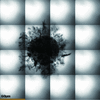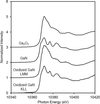issue contents
November 2019 issue

Cover illustration: Coherent mode decomposition of the X-ray beam at the ultra-low emittance X-ray synchrotron source (see Khubbutdinov, Menushenkov and Vartanyants, pages 1851-1862).
facility information
research papers
NEUTRON | SYNCHROTRON
Open  access
access
 access
accessCoherence properties of the fourth-generation high-energy storage rings with low-emittance values are discussed.
The optimization of a phase-space beam position and size monitor is performed by ray-tracing simulation to maximize the instrument sensitivity and resolution for diffraction-limited light sources.
Open  access
access
 access
accessThe surface figure of an X-ray mirror was corrected by differential deposition and measured by off-line metrology.
Open  access
access
 access
accessA novel, asymmetrically cut, channel-cut crystal was designed and manufactured with the aim to significantly reduce the beam offset change during energy scans. The improvement was verified with synchrotron radiation from an undulator source. The importance of even small, generally so far neglected, asymmetries is pointed out for high-accuracy monochromators.
A hierarchical scheme of the calculations of an X-ray beamline for coherent applications is presented. Starting from simple calculations to partial coherence calculations, ray-tracing and wave optics software are applied to simulate the beamline performances.
Light source based on a 100 mm-long monolithic undulator magnet with a very short 4 mm-period length
An in-vacuum undulator with a very short 4 mm-period length has been successfully developed. First observation and characterization of blue light emitted from this undulator was accomplished with the S-band linac operating at 33.5 MeV at the Research Center for Electron Photon Science, Tohoku University, Japan.
A new walking-mode for an elliptical polarized undulator is introduced to save machine-study time for feed-forward scanning.
Conditions for phase-space matching between a bent Laue crystal and a flat Bragg crystal, and between a double-bent Laue monochromator and a flat Bragg crystal, are derived. The concept of phase-space manipulation via a bent Laue crystal is introduced and applied to practical examples of phase-contrast X-ray imaging.
Open  access
access
 access
accessArea detector calibration can be improved greatly by translating the detector to multiple distances from the sample.
Synchrotron X-ray irradiation on continuous-flow aqueous precursors produced conducting Au nano-meshes suitable for transparent and flexible electrodes for optoelectronics.
By fitting photoelectron intensity versus energy to numerically derived curves, the thickness and coverage of carbon coatings on silicon materials destined for use as negative electrodes in lithium-ion batteries can be obtained.
A confocal optic X-ray fluorescence and X-ray absorption spectroscopy system was introduced to monitor the heterogeneous radiation-induced processes of tetrachloroauric solution. The results verify the feasibility of the confocal system in X-ray stimulated processes.
A new apparatus has been developed for grazing-incidence infrared reflectivity measurements at temperatures down to 7 K. The setup is adapted for studying adsorbed molecules on surfaces or ultrathin electron layers that form at the interface of two insulators.
A surface-sensitive measurement of Ga K-edge extended X-ray absorption fine structure is proposed for GaN by detecting Ga LMM Auger electrons originating from Ga K-shell absorption. The analysis depth was less than 10 nm, where the depth reached by 1/e intensity is 2.3 nm.
Combining a MHz-rate optical laser and the micro-focused broadband first harmonic of the undulator radiation at Sector 7 of the Advanced Photon Source, time-resolved pump/probe X-ray emission spectroscopy of dilute transition metal complexes in solution is captured with tens of picoseconds temporal resolution with acquisition times reduced by more than two orders of magnitude.
Application of partial correlation and spatial regression analyses to µ-XRF and µ-XANES data provides insights on the relative contributions of different elements in geochemically heterogeneous soil solids to arsenate accumulation.
X-ray absorption spectra can be recorded at different points in time during a cyclic voltammetry experiment. This time-resolved X-ray spectroelectrochemistry technique can be used to probe transient species formed at an electrode in solution.
The controllability of cupric particle synthesis by X-ray radiolysis is demonstrated.
Open  access
access
 access
accessA highly effective way to cope with the weak signals in hard X-ray angular-resolved photoelectron spectroscopy is introduced. Full-field momentum imaging combined with time-of-flight parallel energy recording constitute a 3D recording scheme, gaining two orders of magnitude in detection efficiency.
A comparative study of distinct mounting strategies of biological tissue samples for X-ray microtomography measurements and their implications on morphometric analysis of soft structures is presented.
The synchrotron-radiation-based phase-contrast imaging method is a more effective tool than absorption-contrast imaging for systematic visualization of cerebral microvasculature, which holds considerable promise for wider application in life sciences, including 3D micro-imaging in experimental models of neurodevelopmental and vascular disorders.
The PUMA (Photons Utilisés pour les Matériaux Anciens) beamline is made available to scientific communities studying materials from cultural heritage. A detailed analytical characterization of this beamline as an analytical and imaging tool is demonstrated using the Seymchan pallasite meteorite and an Antarctic unmelted micrometeorite as case studies.
A new zone plate reflection X-ray microscope is presented for magneto-optical domain imaging in the EUV and X-ray range.
short communications
A new method using intensity correlation of X-ray fluorescence is proposed and demonstrated for temporal diagnostics of femtosecond and attosecond X-ray free-electron laser pulses.
computer programs
A framework for Bragg coherent X-ray diffraction imaging simulations is presented, including MATLAB scripts for easy mapping between the different coordinate frames involved. Using a generalized geometry, this framework is easily adapted to any beamline configuration.
beamlines
The new TES 8-BM beamline at the National Synchrotron Light Source II provides capabilities for microbeam and in situ X-ray absorption spectroscopy (XANES and EXAFS), and X-ray fluorescence imaging in the tender (2–5 keV) energy range. Design, commissioning challenges and example measurements are presented.
Adequate time-resolved X-ray absorption spectroscopy (TR-XAS) signal in a 0.3 mM solution was acquired after laser pump/X-ray probe upgrades. Implementation of simultaneous measurement of both time-resolved X-ray diffraction (TR-XRD) and TR-XAS in a SrCoO2.5 thin film was carried out.
Open  access
access
 access
accessThe transmission of the optical components of the Bernina branch of the Aramis beamline at SwissFEL has been measured with an X-ray gas monitor from DESY and compared with a PSI gas detector upstream of the optical components. The transmission efficiencies of the mirrors and the various other in-beam components were evaluated and compared with theoretical calculations.
A new dual user-present and mail-in X-ray absorption near-edge structure (XANES) facility at the University of Washington is reported and the scope of interplay of synchrotron radiation and tabletop X-ray spectroscopy is discussed.
teaching and education
Free 

What are the relativistic phenomena that boost the power of synchrotron radiation? Quantum properties bring them to light.


 journal menu
journal menu






















































